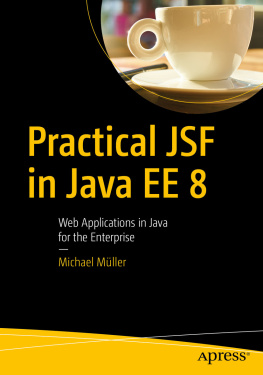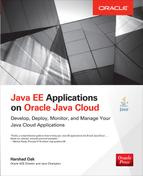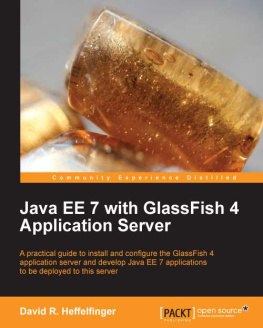Vishal Layka [Vishal Layka] - Learn Java for Web Development: Modern Java Web Development
Here you can read online Vishal Layka [Vishal Layka] - Learn Java for Web Development: Modern Java Web Development full text of the book (entire story) in english for free. Download pdf and epub, get meaning, cover and reviews about this ebook. year: 2014, publisher: Apress, genre: Computer. Description of the work, (preface) as well as reviews are available. Best literature library LitArk.com created for fans of good reading and offers a wide selection of genres:
Romance novel
Science fiction
Adventure
Detective
Science
History
Home and family
Prose
Art
Politics
Computer
Non-fiction
Religion
Business
Children
Humor
Choose a favorite category and find really read worthwhile books. Enjoy immersion in the world of imagination, feel the emotions of the characters or learn something new for yourself, make an fascinating discovery.
- Book:Learn Java for Web Development: Modern Java Web Development
- Author:
- Publisher:Apress
- Genre:
- Year:2014
- Rating:3 / 5
- Favourites:Add to favourites
- Your mark:
Learn Java for Web Development: Modern Java Web Development: summary, description and annotation
We offer to read an annotation, description, summary or preface (depends on what the author of the book "Learn Java for Web Development: Modern Java Web Development" wrote himself). If you haven't found the necessary information about the book — write in the comments, we will try to find it.
Web development is still one of todays most popular, active, and important programming and development activities. From a single web page to an e-commerce-enabled web site to a fully-fledged web application, the Java programming language and its frameworks allow you great flexibility and productivity for your web application development.
Learn Java for Web Development teaches web developers who are new to Java key skills, Java-based languages, and frameworks to build simple or complex web sites and applications. As soon as you pick up this book, Vishal Laykas experience guides you on a very practical learning and building journey.
You will learn the Java nuts and bolts necessary to build a simple HelloWorld Java (native) application, as well as a HelloWorld Java-based web application example that utilizes servlets and Java Server Pages (JSPs). Over the course of the book, youll learn more about servlets and JSPs and delve into Java Server Faces (JSFs) and the expression language found in each of these by applying them in a real-world case studya book store e-commerce application. Then youll build your web application using Apache Struts2 and the Spring MVC framework.
The book concludes by exploring the web application that youve built and examining industry best practices and how these might fit with your application, as well as covering alternative Java Web frameworks like Groovy/Grails and Scala/Play 2. You also can explore the basics of Java, Groovy, and Scala in the books appendices.
While reading this book, youll see all this in action and you can use it as a starting point for further Java web development. Study and experiment with the many source code examples, and later apply them to your own web application building endeavors and 2:00 AM challenges.
What youll learn
How to build your first Java-based web applications with servlets and JSPs
How to apply best practices to web application development
How to build web applications with JSF 2
How to build web applications with the Struts2 framework
How to build web applications with the Spring 3 Web MVC framework
How to build web applications with Grails and Play 2
How to debug and deploy your web application along the way
Who this book is for
This book is for current or aspiring web developers who have some programming experience, but have no or little prior experience using the Java programming language and the available frameworks for Java in web development.
Vishal Layka [Vishal Layka]: author's other books
Who wrote Learn Java for Web Development: Modern Java Web Development? Find out the surname, the name of the author of the book and a list of all author's works by series.

![Vishal Layka [Vishal Layka] Learn Java for Web Development: Modern Java Web Development](/uploads/posts/book/119395/thumbs/vishal-layka-vishal-layka-learn-java-for-web.jpg)






![Fu Cheng [Fu Cheng] - Exploring Java 9: Build Modularized Applications in Java](/uploads/posts/book/119397/thumbs/fu-cheng-fu-cheng-exploring-java-9-build.jpg)
![Wallace Jackson [Wallace Jackson] - Beginning Java 8 Games Development](/uploads/posts/book/119391/thumbs/wallace-jackson-wallace-jackson-beginning-java.jpg)


 Vishal Layka is the chief technology officer of Star Protocol. He is involved in the architecture, design, and implementation of distributed business systems, and his focus is on consulting and training with the JVM languages. His language proficiencies include Java, Groovy, Scala, and Haskell. Vishal is also the lead author of Beginning Groovy, Grails, and Griffon (Apress, 2012). When he needs a break from technology, Vishal reads eclectically from calculus to star formation.
Vishal Layka is the chief technology officer of Star Protocol. He is involved in the architecture, design, and implementation of distributed business systems, and his focus is on consulting and training with the JVM languages. His language proficiencies include Java, Groovy, Scala, and Haskell. Vishal is also the lead author of Beginning Groovy, Grails, and Griffon (Apress, 2012). When he needs a break from technology, Vishal reads eclectically from calculus to star formation. Boris Minkin is a senior technical architect at a major financial corporation. He has more than 20 years of experience working in various areas of information technology and financial services. Boris obtained his masters degree in information systems at Stevens Institute of Technology in New Jersey. His professional interests are in Internet technology, service-oriented architecture, enterprise application architecture and development, cloud computing, distributed caching, Java, and grid and high-performance computing. You can contact Boris at .
Boris Minkin is a senior technical architect at a major financial corporation. He has more than 20 years of experience working in various areas of information technology and financial services. Boris obtained his masters degree in information systems at Stevens Institute of Technology in New Jersey. His professional interests are in Internet technology, service-oriented architecture, enterprise application architecture and development, cloud computing, distributed caching, Java, and grid and high-performance computing. You can contact Boris at .